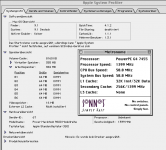Bolle
Well-known member
I snatched up one of the faster Sonnet G4 upgrades for old world PCI machines recently. It was the 700MHz/1MB model. They made that same card in 800/1 and 1000/2 configuration as well.
Only a few of the 1GHz one were ever made when Sonnet was selling off the remaining cards and Motorola supposedly could not deliver any slower 700MHz and 800MHz chips anymore.
Knowing that they just stuck a faster chip on their existing board design made me think... why not go full retard and head for the latest and greatest the 7455-line of CPUs has to offer?
The 7455 has bus/cpu multipliers going up to 28x and the fastest chip available is rated 1400MHz - as if that was not made to be run on a 50MHz bus in an old world Power Mac.
I started gathering some donor boards right away: a dual 1.42 MDD CPU board with one dead CPU and another Sonnet CPU upgrade with a dead CPU for 2MB worth of cache.
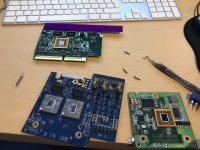
A quick test if my newly acquired upgrade works at all - it did: so off with the unwanted stuff:
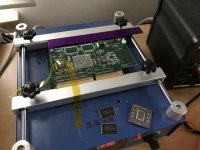
Preparing the donor CPU...
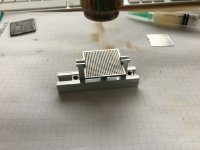
...and onto the board it goes:
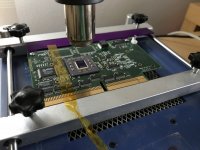
The additional address line on the bigger cache chips is routed to the CPU as expected so on there with them as well:

Screwed on the heatsink, dropped it into my 9600 and it chimed right away.
It clocks up to 1.4GHz nicely and seems to run stable. I set the CPU core voltage to 1.45V - 1.40V would not boot as well as 1.55 wouldn't leaving me with only 1.45V or 1.5V to choose.
At the moment I am still having issues getting the L3 cache to work. It does not want to detect either the original 1MB or the 2MB I did steal from the other upgrade.
Let's see how that can be solved...
Only a few of the 1GHz one were ever made when Sonnet was selling off the remaining cards and Motorola supposedly could not deliver any slower 700MHz and 800MHz chips anymore.
Knowing that they just stuck a faster chip on their existing board design made me think... why not go full retard and head for the latest and greatest the 7455-line of CPUs has to offer?
The 7455 has bus/cpu multipliers going up to 28x and the fastest chip available is rated 1400MHz - as if that was not made to be run on a 50MHz bus in an old world Power Mac.
I started gathering some donor boards right away: a dual 1.42 MDD CPU board with one dead CPU and another Sonnet CPU upgrade with a dead CPU for 2MB worth of cache.

A quick test if my newly acquired upgrade works at all - it did: so off with the unwanted stuff:

Preparing the donor CPU...

...and onto the board it goes:

The additional address line on the bigger cache chips is routed to the CPU as expected so on there with them as well:

Screwed on the heatsink, dropped it into my 9600 and it chimed right away.
It clocks up to 1.4GHz nicely and seems to run stable. I set the CPU core voltage to 1.45V - 1.40V would not boot as well as 1.55 wouldn't leaving me with only 1.45V or 1.5V to choose.
At the moment I am still having issues getting the L3 cache to work. It does not want to detect either the original 1MB or the 2MB I did steal from the other upgrade.
Let's see how that can be solved...

